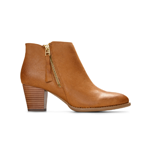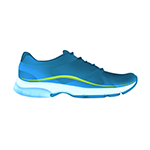
HOW SHOULD BOOTS FIT?

Boots are a fall and winter wardrobe staple for men and women alike. They keep your feet warm, dry, and present a practical, ready-for-anything vibe. But when boots don’t fit properly, they don’t look or feel nearly as good as they should. Ill-fitting footwear can lead to serious pain and discomfort, almost defeating the purpose of wearing shoes altogether.
So, how should boots fit? The footwear experts at Vionic are here to set the record straight. Find tips and guidance for finding the right fit for boots and booties for women below.
How Are Boots Supposed to Fit?
As a winter shoe designed to protect your feet from the elements, boots aren’t like sneakers, ballet flats, dress shoes, and other footwear styles. Even if you have a pretty good idea of how other shoes should fit, you might be wondering, How are boots supposed to fit?
The answer to this question depends on a variety of factors, including the style of boot and the type of socks you’re wearing. However, following a few best practices can help you get it right. We’ve compiled some useful pointers for finding the proper fit when it comes to our stylish boots for women. Check them out below.
Not Too Tight, Not Too Loose
In general, boots should not be too loose or too tight. If they’re too loose, your heel will move up and down within the shoe as you walk. This may result in overpronation, heel pain, plantar fasciitis, or an inflamed Achilles tendon. If they’re too tight, it can create friction and rubbing, leading to blisters, calluses, or Morton’s neuroma (pinched nerves in the toes)[2]. Either way, you’re looking at substantial foot pain.
How do you know if a boot is too loose or tight? It should align with the instep and ball of your foot, holding it in place like a firm handshake. Since many boot styles are more spacious than regular shoes, it’s important that they fit snuggly along the bottom of your foot[1].
And this should go without saying, but boots should never be so tight that they make your toes feel cramped or uncomfortable. You can expect a break-in period, especially with leather styles, but if your toes are pressing against the front of a boot, it’s too tight.
How to Check if Your Boots Are Too Tight
One way to tell is by placing your finger between the back of your ankle and the back of the boot. One finger should fit easily in the space, but if you can fit two, the boots are probably too loose. If your toes feel jammed with a finger behind your ankle, they’re most likely too tight.
Another way to test it is to put your boots on, stand up straight, and then wiggle your toes. If you can’t wiggle your toes, the boot is too tight. We also recommend walking around in them for a minute or two. If your feet are sliding around, they’re too loose.
Finding the Right Size
On average, women’s feet are a little over 9 inches, and men’s feet are usually closer to 11 inches. With any pair of shoes, getting the proper size is essential. If you haven’t measured your feet lately (or ever), we suggest doing so before buying a pair of boots.
Grab a piece of paper, a pen, and a ruler or tape measure. Stand on the paper, and then trace around your entire foot. (You should actually trace both feet, as some people have slightly different lengths on their right and left sides.) Using the ruler or measuring tape, measure the distance from your longest toe to the very back of your heel. This is the length of your foot[3].
Of course, the length of your foot isn’t the length of the boots you need. Properly fitting footwear will typically be somewhere between 0.25 and 0.5 inches longer than your feet. Since sizes can vary among brands, check out the manufacturer’s size chart or fit guide to get an idea of what size you need.
Appropriate Boot Width
Length is only half of the equation for determining the proper boot size. Though most people have medium-width feet, many run slightly wider or narrower. When measuring your feet, we also recommend checking the width. The average woman’s foot is about 3.5 inches wide, and for men, it’s usually right around four inches. If your feet fall a half-inch or more outside the average, you might need wide boots.
Bear in mind that boots tend to be wider than most shoes, so you don’t be able to tell if they’re too wide just by looking at them. For instance, snow boots, ski boots, and hiking boots are notably broad. Proper width is about how your foot feels inside a boot.
If you’re considering a pair of boots that only come in one width, you might have to go up or down a half size to accommodate your feet. This is because shoe sizes get gradually wider as they go up. For instance, a size 8 boot will be about an eighth of an inch wider than a 7.
Even Weight Distribution
When searching for the right boot fit, you should be mindful of how your weight is distributed. Ideally, it will be evenly distributed across the sole. Shoes that are too small can make your feet tilt forward or to the side. A boot that’s too large will often make your heel lift up as you walk. Heel slippage is something you definitely want to avoid, as it can result in overpronation, plantar fasciitis, and other painful foot conditions.
Consider Your Socks
Another thing to keep in mind is socks. Unlike other shoe styles, boots are pretty much always worn with socks. But as you know, not all socks are created equal. Similar to trying on an athletic shoe, if you plan to wear a thick sock with your winter boots, you should try them on with a thick sock. Otherwise, you might get home and realize they’re too small.
If you plan to wear your boots with different types of socks or tights, you can get a boot liner to make up for thinner materials. Also, you can remove the insole to make room for thicker socks. Vionic carries several orthotics for men and women. You can always use them in place of thick footbeds if needed.
When wearing socks, boots should feel snug but never tight. However, new boots will need to be broken in, especially if they’re made of real leather. You can expect them to be a little extra snug at first and relax after several wears.
Check the Toe Boxes
Another crucial factor in how boots should fit is the toe box. This is the area in the front of a shoe where your toes go, and it shouldn’t stretch with a pair of boots—even leather boots. Most boot styles have a semi-hard toe box. It’s there to protect your toes and shouldn’t put pressure on them. If you can wiggle your toes in the toe box, it’s a good sign in terms of fit.
The Wall-Kick Test
Another way to test out the fit of a boot is with the wall-kick test. As you might imagine, it involves gently kicking a wall while wearing your boots. If your toes cramp upon impact, you probably need a larger size.
Why a Proper Fit Is Essential
A proper fit is vital because ill-fitting boots can be hard to walk in, cause alignment issues, and lead to severe foot pain. Boots should not hurt—we can’t stress this enough. Many people become used to suffering in shoes in the name of fashion, but it’s really not necessary.
A Comfortable, Perfect Fit With Vionic

The men’s and women’s boot collections from Vionic include a broad range of fashion-forward designs. Each pair is engineered with our exclusive Vio-Motion Support orthotics, so you can count on deep heel cups, stability, arch support, and cushioning.
Our women’s boots and booties are available in whole and half sizes and many come in both medium and wide widths. Men’s boots from Vionic are available in whole and half sizes. To get the most comfort out of your boots, we recommend wearing them for just a few hours the first couple of times. This will help you break them in and give your feet time to adjust to the orthotics. Within a week or two, you’ll be loving the feel of your supportive boots. To experience the Vionic difference, shop the different types of boots in our collection today.
Looking for more boot advice? Check out our guide on how to wear ankle boots!
Sources:
1. https://survivalmag.net/how-boots-should-fit/
2. https://www.webmd.com/skin-problems-and-treatments/understanding-corns-calluses-prevention
3. https://www.health.harvard.edu/staying-healthy/10-tips-for-finding-the-right-shoes









